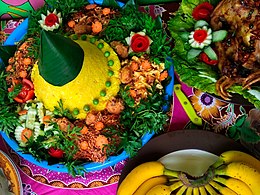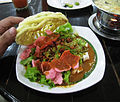
Indonesian cuisine is a collection of various regional culinary traditions that formed in the archipelagic nation of Indonesia. There are a wide variety of recipes and cuisines in part because Indonesia is composed of approximately 6,000 populated islands of the total 17,508 in the world's largest archipelago, with more than 1,300 ethnic groups.

Malay cuisine is the traditional food of the ethnic Malays of Southeast Asia, residing in modern-day Malaysia, Indonesia, Singapore, Brunei, Southern Thailand and the Philippines as well as Cocos Islands, Christmas Island, Sri Lanka and South Africa.

Chinese Indonesian cuisine is characterized by the mixture of Chinese with local Indonesian style. Chinese Indonesians, mostly descendant of Han ethnic Hokkien and Hakka speakers, brought their legacy of Chinese cuisine, and modified some of the dishes with the addition of Indonesian ingredients, such as kecap manis, palm sugar, peanut sauce, chili, santan and local spices to form a hybrid Chinese-Indonesian cuisine. Some of the dishes and cakes share the same style as in Malaysia and Singapore, known as Nyonya cuisine by the Peranakan.

A rice cake may be any kind of food item made from rice that has been shaped, condensed, or otherwise combined into a single object. A wide variety of rice cakes exist in many different cultures in which rice is eaten. Common variations include cakes made with rice flour, those made from ground rice, and those made from whole grains of rice compressed together or combined with some other binding substance.

Peranakan cuisine or Nyonya cuisine comes from the Peranakans, descendants of early Chinese migrants who settled in Penang, Malacca, Singapore and Indonesia, inter-marrying with local Malays. In Baba Malay, a female Peranakan is known as a nonya, and a male Peranakan is known as a baba. The cuisine combines Chinese, Malay, Javanese, South Indian, and other influences.

Lontong is an Indonesian dish made of compressed rice cake in the form of a cylinder wrapped inside a banana leaf, commonly found in Indonesia, Malaysia, and Singapore. Rice is rolled inside a banana leaf and boiled, then cut into small cakes as a staple food replacement for steamed rice. The texture is similar to that of ketupat, with the difference being that the ketupat container is made from woven janur fronds, while lontong uses banana leaf instead.

Javanese cuisine is the cuisine of Javanese people, a major ethnic group in Indonesia, more precisely the province of Central Java, Yogyakarta and East Java.

Padang dish or Minangkabau dish is the cuisine of the Minangkabau people of West Sumatra, Indonesia. It is among the most popular cuisines in Maritime Southeast Asia. It is known across Indonesia as Masakan Padang after Padang, the capital city of Western Sumatra province. It is served in restaurants mostly owned by perantauan (migrating) Minangkabau people in Indonesian cities. Padang food is ubiquitous in Indonesian cities and is popular in neighboring Malaysia and Singapore.

Sundanese cuisine is the cuisine of the Sundanese people of Western Java, and Banten, Indonesia. It is one of the most popular foods in Indonesia. Sundanese food is characterised by its freshness; the famous lalab eaten with sambal and also karedok demonstrate the Sundanese fondness for fresh raw vegetables. Unlike the rich and spicy taste, infused with coconut milk and curry of Minangkabau cuisine, the Sundanese cuisine displays the simple and clear taste; ranged from savoury salty, fresh sourness, mild sweetness, to hot and spicy.

Lontong cap go meh is a Chinese Indonesian take on traditional Indonesian dishes, more precisely Javanese cuisine. It is lontong rice cake served with richly-flavoured dishes which include opor ayam chicken in coconut milk, sayur lodeh vegetable soup, hot and spicy liver, hard-boiled pindang egg, koya powder made of soy and dried shrimp or beef floss, pickles, chili paste and prawn cracker. Lontong cap go meh is usually consumed by Chinese Indonesian community during the Cap go meh celebration.

Ketupat, or kupat, or tipat is a Javanese rice cake packed inside a diamond-shaped container of woven palm leaf pouch, Originating in Indonesia, it is also found in Brunei, Malaysia, Singapore and southern Thailand. It is commonly described as "packed rice", although there are other types of similar packed rice such as lontong and bakchang.

Soto is a traditional Indonesian soup mainly composed of broth, meat, and vegetables. Many traditional soups are called soto, whereas foreign and Western influenced soups are called sop.

Gado-gado is an Indonesian salad of raw, slightly boiled, blanched or steamed vegetables and hard-boiled eggs, boiled potato, fried tofu and tempeh, and lontong, served with a peanut sauce dressing.

Palembangese cuisine is the cuisine of the Palembangese people of the city of Palembang in the South Sumatra province of Indonesia. It is the second most well-known cuisine from Sumatra after Padang.

Acehnese cuisine is the cuisine of the Acehnese people of Aceh in Sumatra, Indonesia. This cuisine is popular and widely known in Indonesia. Arab, Persian, and Indian traders influenced food culture in Aceh although flavours have substantially changed their original forms. The spices combined in Acehnese cuisine are commonly found in Indian and Arab cuisine, such as ginger, pepper, coriander, cumin, cloves, cinnamon, cardamom, and fennel.

Indian Indonesian cuisine is characterized by the mixture of Indian cuisine with local Indonesian-style. This cuisine consists of adaptations of authentic dishes from India, as well as original creations inspired by the diverse food culture of Indonesia. Indian influence can be observed in Indonesia as early as the 4th century. Following the spread of Islam to Indonesia and trading, Muslim Indian as well as Arab influences made their way into Indonesian cuisine. Examples include Indian biryani, murtabak, curry and paratha that influenced Acehnese, Minangkabau, Malay, Palembangese, Betawi and Javanese cuisine.

Madurese cuisine is the culinary tradition of the Madurese people from Madura Island in Indonesia. This cuisine is particularly well-known in the neighboring areas of East Java, as well as on the south coast of Kalimantan. As a leading salt production center in the Indonesian archipelago, Madurese dishes are often saltier compared to Eastern Javanese cuisine, although with significant Javanese influences.

Indonesian noodles are a significant aspect of Indonesian cuisine which is itself very diverse. Indonesian cuisine recognizes many types of noodles, with each region of the country often developing its own distinct recipes.

Banjarese cuisine is the cooking tradition and cuisine of Banjar people of South Kalimantan in Indonesia. Banjar cuisine also found in neighbor countries as following Brunei, Malaysia to Singapore.

Indo cuisine is a fusion cooking and cuisine tradition, mainly existing in Indonesia and the Netherlands, as well as Belgium, South Africa and Suriname. This cuisine characterized of fusion cuisine that consists of original Indonesian cuisine with Eurasian-influences—mainly Dutch, also Portuguese, Spanish, French and British—and vice versa. Nowaday, not only Indo people consume Indo cuisine, but also Indonesians and Dutch people.











































